DIVISION OF THE NERVOUS SYSTEM

The nervous system can be divided into several connected systems that function together. Let's start with a simple division:
The nervous system is divided into the central nervous system and peripheral nervous system.
Peripheral Nervous System
The peripheral nervous system is divided into two major parts: the somatic nervous system and the autonomic nervous system.
Somatic Nervous System
The somatic nervous system consists of peripheral nerve fibers that send sensory information to the central nervous system AND motor nerve fibers that project to skeletal muscle.
The picture on the left shows the somatic motor system. The cell body is located in either the brain or spinal cord and projects directly to a skeletal muscle.
Autonomic Nervous System
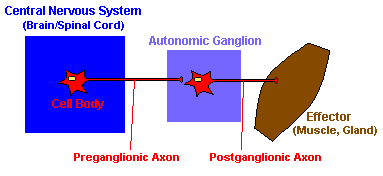 Th
Th
e autonomic nervous system is divided into three parts: the sympathetic nervous system, the parasympathetic nervous system and the enteric nervous system. The autonomic nervous system controls smooth muscle of the viscera (internal organs) and glands.
This picture shows the general organization of the autonomic nervous system. The preganglionic neuron is located in either the brain or the spinal cord. This preganglionic neuron projects to an autonomic ganglion. The postganglionic neuron th
en projects to the target organ. Notice that the somatic nervous system has only one neuron between the central nervous system and the targe
t organ while the autonomic nervous system uses two neurons.
| Divisions of the Nervous System | ||
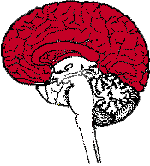 Telencephalon Telencephalon | 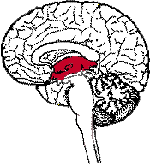 Diencephalon Diencephalon | 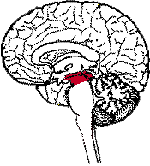 Mesencephalon Mesencephalon |
 Metencephalon Metencephalon | 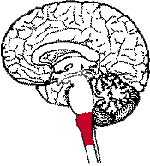 Myelencephalon Myelencephalon |
From a top view, notice how the brain is divided into two halves, called hemispheres. Each hemisphere communicates with the other through the corpus callosum, a bundle of nerve fibers. (Another smaller fiber bundle that connects the two hemispheres is called the anterior commissure).
Some differences between the peripheral nervous system (PNS) and the central nervous system (CNS):
- In the CNS, collections of neurons are called nuclei. In the PNS, collections of neurons are called ganglia.
- In the CNS, collections of axons are called tracts. In the PNS, collections of axons are called nerves.
In the peripheral nervous system, neurons can be functionally divided in three ways:
- Sensory (afferent) - carry information INTO the central nervous system from sense organs or motor (efferent) - carry information away from the central nervous system (for muscle control).
- Cranial - connects the brain with the periphery or spinal - connects the spinal cord with the periphery.
- Somatic - connects the skin or muscle with the central nervous system or visceral - connects the internal organs with the central nervous system.
Cerebral Cortex
Functions:
- Thought
- Voluntary movement
- Language
- Reasoning
- Perception
Cerebellum
Functions:
- Movement
- Balance
- Posture
Brain stem
Functions: 
- Breathing
- Heart Rate
- Blood Pressure
Hypothalamus
Functions: 
- Body Temperature
- Emotions
- Hunger
- Thirst
- Circadian Rhythms
Thalamus
Functions: 
- Sensory processing
- Movement
Limbic System
Functions:
- Emotions
- Memory
Hippocampus
Functions:- Learning
- Memory
Basal Ganglia
Functions:
- Movement
The basal ganglia are a group of structures, including the globus pallidus, caudate nucleus, subthalamic nucleus, putamen and substantia nigra, that are important in coordinating movement.
Midbrain
Functions:
- Vision
- Audition
- Eye Movement
- Body Movement
The midbrain includes structures such as the superior and inferior colliculi and red nucleus. There are several other areas also in the midbrain.

.jpg)
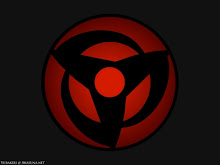
No hay comentarios:
Publicar un comentario